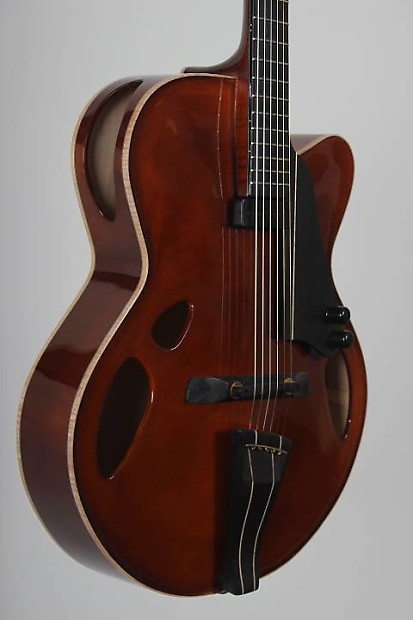-
Anyone use a guitar with one (upper bout rim)? Does is work well?
-
04-25-2024 09:37 PM
-
I only had one that I forgot the name (some guy had gits made and imported them) of because I sent it back as it had many top cracks that the seller did not reveal.
That said, despite the cracks it BOOMED sound and air out of that upper bout rim so much so I almost kept it.
-
I have two guitars with sound ports. The Beardsell short-scale high-A flattop is almost all soundport on the upper bout and delivers a lot more volume than you would hear from the top if there was no port. The Solomon archtop has a small oval hole on the top and a small soundport on the upper bout. As I usually play it with the top edge angled back towards me I don't derive much benefit from the port (as it is pointing to my chest). I don't think the soundports detract from the sound projected towards the audience, but by the same token I don't know whether what the audience hears is exactly what I hear from the port. All of this for purely acoustic playing -- when the guitar is amplified the port is mostly irrelevant.
-
On the Benedetto style archtops (solid, carved) from Wu and Yunzhi, ports are huge. Very easy to test playing with them covered to see the difference so it's not just an impression. Port applies even at low amplification. I think five of mine have ports and one without. After 15 years of playing with them in acoustic archtops, I would want a port in any acoustic instrument.
As an aside, would be interesting to see is if an electric archtop (ES175 or L5 style) would be more interesting unplugged for practice if they had a port.
-
Yes, if you play an acoustic archtop, the port is a very good thing. It fills in those lower midrange frequencies that you otherwise wouldn’t hear so well.
-
Yes
A side port is just a way for the player to actually enjoy listening to the guitar.
Makes sense given you’re the one that plays it the most and paid for it.
-
My Cabaret has one, and I usually keep it closed with a plug I made because it gets too loud for practise.
I too would say it mostly boosts what I hear of the mid/low frequencies but like with shifting the soundhole north it raises the main air resonance. By about a semitone on mine (without compare to with plug).
-
I appreciate the utility of a sound port, but not the aesthetics, so I've never bought a guitar with one. That being said, there was a post on this site some years back of an Elferink build that had maybe the nicest looking sound port I've seen. Alas the photos are gone.
-
My opinion:
Hideous affectation. Never.
-
I have a Ruck 2010 classical with a sound port. Ruck provided wooden plugs so you can plug the hole and tell the difference. There is a huge difference in the sound you're hearing as a player. With the holes open, it's very powerful and clean. With the holes plugged, it's still a wonderful guitar, but more of a "traditional" sound. As a listener, from in front of the guitar, there's absolutely no difference at all. I think this thread is about archtops, not classical, but the concept I suppose is the same. They are pretty common on the modern classical guitars.
-
-
Hate them. An abomination on the beautiful aesthetics of the traditional guitar and violin. Did Stradivarius have sound ports?
OK rant over. I never believed in them, until I tried one and I thought "No WAY. It must be other things contributing to that sound." and then I built a sound hole into an otherwise "normal" guitar and I was shocked.
Then I went to Al Carruth, a luthier of infinite theoretical and practical experience and wisdom and asked "WHat's going on with this?" and he showed me an experiment that was done with a violin that was built with holes along the ribs sized so they could be filled with corks in different configurations. The long story short is you'd think it would adversely effect the helmholtz air resonant frequency of even the air mode that's pumped out of the F holes... you'd THINK that but no, it actually frees up the movement of air coming out front, doesn't effect (to any measurable degree) the amplitude or frequencies of air moving off the top plate (where your projection comes from) nor coupling with the back plate (where the vibrational re-enforcement and even profile of a tuned guitar comes from.
Real life translation: Whether you like the way it looks or not, it sounds better. The message: Get over it, it makes better sound and projects better -and if you mic a suspended acoustic microphone there, it's the best way to get the sound of the guitar into a PA.
Huh. I hate to admit it, but yeah, it works. Really well.
-




 Reply With Quote
Reply With Quote










New Stool Day
Today, 02:48 PM in Guitar, Amps & Gizmos